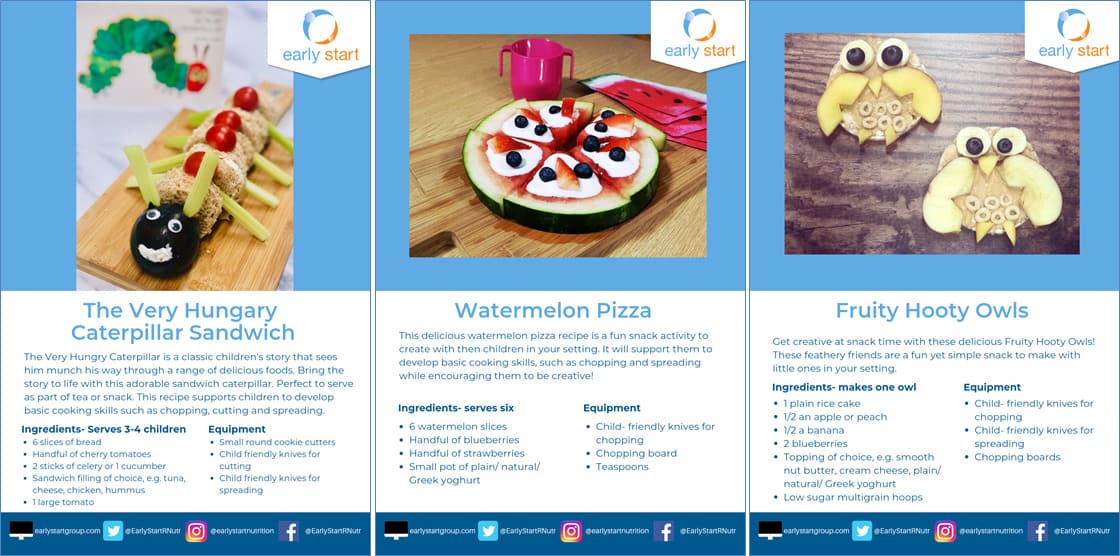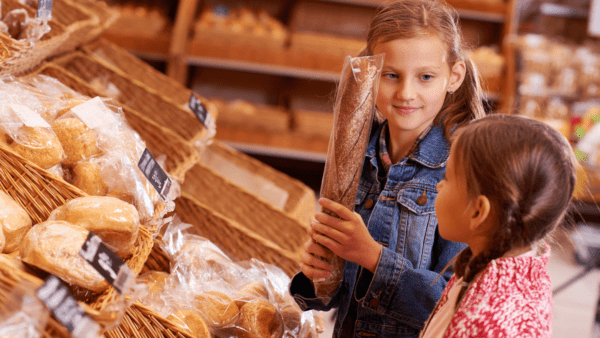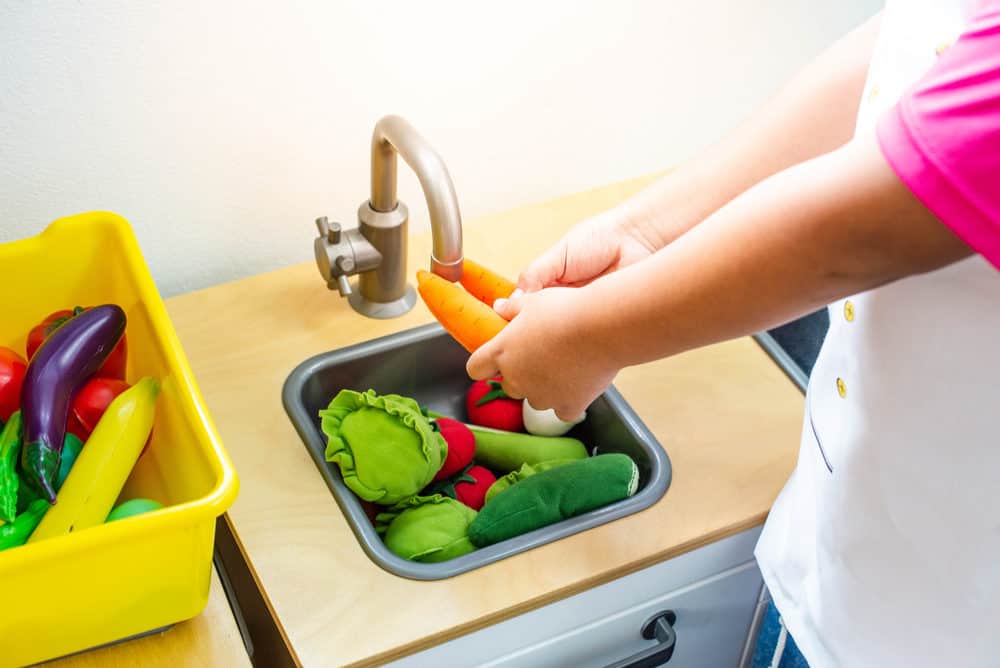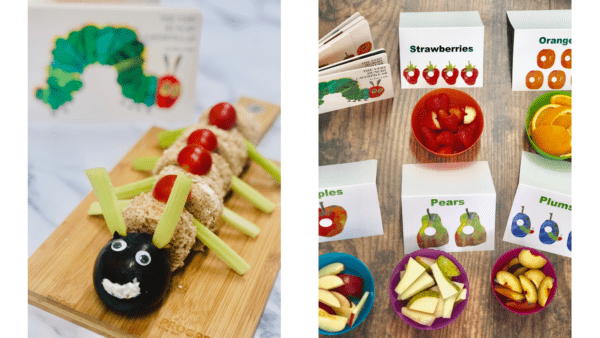There are so many benefits to providing early years children with opportunities to cook and learn about food. Food based activities for children can have the following benefits:
- Supports children to try new foods– they become familiar with the sensory properties of foods, such as smell, taste and texture
- Positive food exposure– can help to support fussy/ picky eaters
- Supports physical development– e.g. hand eye coordination
- Learn about food- e.g. how it grows and where it comes from
- Great learning environment- e.g. language, math, science, creativity
- Social and emotional-e.g. team work, turn taking
- Builds confidence and self- esteem
- It’s fun!

Cooking Activities:
When planning cooking sessions with young children, it’s important to think about the cooking skills you want them to learn and practice e.g. pouring, mixing, spreading and sifting
As with everything, children’s abilities will differ so you need to use your own judgment to choose tasks you think are suitable for the children in your care.
Safety is the biggest concern, beyond that a little trial and error is all part of the fun!
Choose simple and fun recipes when cooking with children (see example below). Choose colourful foods and encourage children to be creative!
Need more confidence in delivering cooking activities? Book our online Cooking and Learning about Food training (opens in new tab), designed specially for early years practitioners (only £30)!

Other ways to teach children about food
In addition to mealtimes and cooking activities, it’s important that early years settings provide plenty of opportunity for children to learn about and explore foods.
Education Visit
There are a number of places that early years settings can visit to increase children’s understanding of where food comes from, farming and the natural environment. These include:
- A trip to the local shop or supermarket-Learning outcomes for children may include where food comes from through food finding activities and how our food transport systems work, as well as understanding food storage and preparation
- Getting involved in local community allotments-Here children could learn about food seasons and how certain foods grow and how the weather can affect foods.
- A trip to local markets-Here children can learn about the cost of foods, where it comes from and how it is delivered and presented.
- Exploring local farms- An arranged visit to a local farm helps children to understand that some foods come from plants and animals and understand the food chain from farm to their plate.Visit Countryside Classroom (opens in new tab) to explore local places to visit

Growing and Gardening Activities
Growing and gardening activities help children to learn about food cycles. washing and eating them and then composting. Gardening is also a good form of physical activity! These activities could include:
- Gardening Preparation: Here children can get in involved in preparing the soil such as digging out weeds, learning about creating the right environment for food to grow as well as when certain foods can be harvested.
- Growing fruits or vegetables- Here children could learn which months are best to grow certain vegetables or fruits, how they grow and washing and making them safe to eat.
- Growing herbs: Here children could learn about the names of certain herbs and what they smell like, as well as life cycles and how to look after plants
- Composting:Here children can learn how compost can help plants grow and how the natural decay process of foods works by getting involved with a compost heap.
For more information and advice on growing a variety of foods, visit the Royal Horticultural Society (opens in new tab)
Sensory Play
As an early years practitioners you understand the importance of providing sensory experiences to stimulate children’s learning from birth. The sensory nature of foodstuffs makes them an ideal resource for this kind of play!
- Vegetable and fruit treasure hunt-hide whole, raw fruits and vegetables in a box of e.g. soil/sand/shredded paper/sawdust, for children to find. Touching the foods will help children to become familiar with it’s sensory properties.
- Feely bags-children enjoy guessing items in a feely sack. Use foods such as dried pasta or vegetables to test their knowledge and learn what certain foods feel like and what they can make, for example potatoes to homemade wedges.
- Smell tables- are a great way for children to explore the smells of food items and learn how to describe them. Try filling a container with different food items, cover with a thin piece of cloth and elastic band and get children to smell and guess what’s inside. You could try: chopped onion, cheese, chopped orange.
- A herb table- is a great way for children to learn about different herbs and their aroma. Using fresh herbs, show children how to rub their fingers and thumbs gently on the leaves and then smell the aroma that has been released. Try parsley, coriander, mint, thyme, chives, sage, rosemary (all of these can be grown in the garden or in containers!).
- Placing food items into a container tray or on a mat-e.g. flour, jelly, pasta ,and let children explore them, learn how describe how foods look, feel and smell.

Role Play
- Imaginative play areas set up as shops, café, grocery stores etc. give children opportunities to act out what they have experienced first-hand and to discover new experiences.
- Not only can these activities help children to learn about food, but they encourage language and communication.
- Your setting should try to include some fresh produce and real foodstuffs to extend children’s vocabulary as well as sensory learning.
- Embrace each child’s cultural identity, and promote diversity, by including produce and utensils from various cultures. Be aware of and respect the variety of cultural differences in cooking and eating (e.g. making tea in a saucepan, eating with fingers, hold a bowl of rice to your mouth to eat from it with chopsticks).

Books and Songs
Books and songs about food are a great way for children to learn about new foods, where they come from and how they are grown. They are also a great way to help develop early literacy, music and numeracy skills.
There are some fantastic food related fiction and nonfiction titles, for example:
- The BFG
- Jack and the Beanstalk-
- I Eat Vegetables
- Handa’s Surprise
- How to Make an Apple Pie and See the World
- The Very Hungary Caterpillar
- Eat your Peas

Interested in finding our more about how to teach cooking and learning about food activities in your setting? Book our online training here (opens in new tab)

